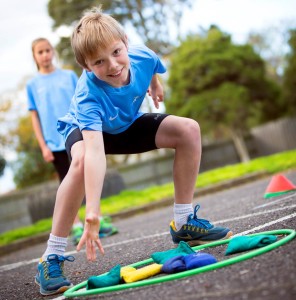
When children are still growing and developing, we need to be mindful of how much is too much, particularly when there are so many opportunities available for kids.
At a young age, children naturally tend to be at their most active. Therefore, it can be a great time to take advantage of this tendency to build upon their physical abilities, improving their self-confidence and self-esteem at an early age. Australian Physical Activity Guidelines for pre-schoolers recommend:
- at least 60 minutes of structured (adult-led) physical activity per day
- at least 60 minutes of unstructured (free play) physical activity per day
- not to be inactive for more than 1 hour at a time unless sleeping
For pre-schoolers, most of their physical exertion should be through active play. Games and fun activities are recommended to encourage participation and teach the children that being active is a normal and enjoyable part of life.
But what is the appropriate age to commence strength and resistance training? How young is too young?
The ASCA, Australian Strength & Conditioning Association, suggest that if a child is ready to participate in organised and structured sports such as cricket, football, rugby, basketball etc. then they are generally ready to perform a supervised resistance training program. Keep in mind, that a resistance training program may include bodyweight exercises, it doesn’t strictly refer to lifting weights.
As children typically enter formal school at the age of 6 years, they may be ready to participate in an organised resistance training program at about this time. However, the actual age will vary from child to child and will be largely dependent on their capacity to follow clear directions and learn the correct exercise techniques.
From a research perspective, Faigenbaum et al. (2003) conducted a study with 32 girls and 64 boys between the ages of 6-12 years that demonstrated that 1 RM (Rep Max) testing using child-sized weight machines was safe and effective.
However, it important to note that strength training with maximal weights, something that an adult might do to stress their muscles, is “not recommended because of the potential injuries that relate to long bones, growth plates and back” (Faigenbaum & Micheli, 1998). In fact, the injury rate from under 16s partaking in powerlifting is 13.8 per 1000 athlete hours. This is much higher than that reported for other youth sports.
While the injury rate in powerlifting was high, weight lifting and general sports training are relatively safe activities. Rielly et al. (2003) followed 20 youth weightlifters, of around 13-16 years old, for their final 8 weeks of preparation for the US National Junior Weightlifting Championships and reported only 0.9 injuries per 1000 hours of participation. A similar value of 0.8 was reported for weightlifters by Risser et al. (1990). These values are much lower than the average of 2.44 reported for other popular youth sports.
Training intensity is something that is often hard to gauge in children, but as a guide to assist in this area, ASCA created 4 levels:
- Level 1: 6-9 years of age: modification of body weight exercises and light resistance (brooms and bands etc) work only for relatively high repetitions eg 15+ reps;
- Level 2: 9-12 years of age: 10-15 RM; (maximal loading approximately 60% maximum) using predominantly simple free weight exercises and machine exercises where the machine is an appropriate size for the child.
- Level 3: 12-15 years of age: 8-15 RM; (maximal loading approximately 70% maximum) using progressively more free weight exercises but avoiding complex lifts such as cleans, snatches, deadlifts and squats etc unless competent coaching is available from a personal trainer with at least a Level 2 ASCA strength and conditioning accreditation.
- Level 4: 15-18 years of age: 6-15 RM; (maximal loading approximately 80% maximum) progressively moving towards an advanced adult program involving split routines where appropriate and complex multi-joint movements provided sound technique has been developed.
To conclude, introducing exercise and training via participation in active games at an early age (eg. pre-school) is recommended for children, as it helps to build good habits and lead to a healthier lifestyle. Once children start formal education they can commence age-appropriate, modified strength training, if they can follow clear instructions.
As children get older, they will be able to gradually handle increased resistance, closer to their maximal loading. However, due to their continued growth throughout this stage of life, care must be taken to avoid loads and intensities that are too difficult as it can lead to injury.
If you’d like to learn more about Resistance Training for Children and Adolescents, it is a subject included within our Certificate IV in Fitness. Upon completing that course you will have a much greater knowledge of safe exercises and recommended exercise intensities and durations for children and adolescents.
References:
Faigenbaum, A. (2003). Youth resistance training. President’s Council on Physical Fitness and Sports Research Digest
Faigenbaum, A., Westcott, W., Long, C., Loud, R., Delmonico, M., Micheli, L. (1998). Relationship between repetitions and selected percentages of the one repetition maximum in children. Pediatric Physical Therapy 10.
ASCA Position Stand 2007 Resistance Training for Children and Adolescents www.strengthandconditioning.org
Australian Physical Activity Guidelines
Byrd R., Pierce K., Rielly L, et al. (2003). Young weightlifters’ performance across time. Sports Biomech.
Risser, W. L., Risser. J. M. H., & Preston. D. (1990) Weight-training injuries in adolescents, American Journal of Diseases of Children






